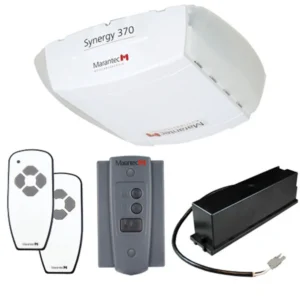Topics Covered:
At RJ Garage Door Services, we’ve worked on countless LiftMaster garage door openers for customers across a wide range of properties. LiftMaster is undoubtedly a reliable brand, but every mechanical system eventually faces wear and tear or unexpected glitches. Our hands-on experience with LiftMaster products has taught us which issues tend to crop up most often—and how to get them resolved before they become major headaches.
Below, we’ll walk you through five of the most common LiftMaster opener repairs we handle. By keeping an eye out for these warning signs, you can minimize downtime, save on bigger repair bills, and ensure your garage door remains a convenient, secure point of access for your home.
1. Worn or Broken Drive Gears
Why It Happens: Inside many LiftMaster openers—particularly chain- or belt-driven models—there’s a plastic gear assembly that transfers power from the motor to the chain or belt. Over time, the constant motion of the opener, combined with temperature swings or insufficient lubrication, can wear these gears down. Eventually, the teeth become so worn (or even stripped) that the door won’t move when you activate the opener.
What We See at RJ Garage Door Services: Customers often call us complaining that their LiftMaster motor sounds like it’s running, but the door itself doesn’t budge. In most cases, we find the internal gears have been ground down, leaving plastic shavings or residue inside the opener’s housing.
Solution and Prevention: Replacing the drive gear assembly is the go-to fix. We’ll open up the motor housing, remove the worn gear, and install a new kit (which often includes the gear, bushings, and fresh grease). To minimize wear, we recommend lubricating the door’s chain (or belt track) every few months and ensuring the chain or belt tension isn’t overtight.
2. Malfunctioning Safety Sensors
Why It Happens: Modern LiftMaster openers include photo eye safety sensors near the garage floor. These sensors detect obstacles—like children or pets—and stop the door from closing on them. Dirt, misalignment, or damaged cables can disrupt the infrared beam between sensors, causing the door to reverse unexpectedly or not close at all.
What We See at RJ Garage Door Services: The door often won’t go past a certain point on its downward travel, reversing halfway. The motor’s light might blink rapidly, signaling a sensor-related error. We also find sensors that have been bumped or knocked out of alignment, especially in busy garages where they can get nudged by brooms, trash bins, or kids’ toys.
Solution and Prevention: The simplest fix can be cleaning the sensors with a soft cloth to remove dust or cobwebs, then realigning them so the LEDs face each other properly. If the wiring is frayed or one sensor is physically cracked, we’ll replace that component. Because sunlight can sometimes interfere with sensors, we may recommend adding a small sun shield or adjusting their angles to avoid direct glare.
3. Gear and Sprocket Assembly Failure
Why It Happens: LiftMaster chain-driven openers feature a sprocket atop the motor shaft, around which the chain loops. Over time, friction and chain tension can wear down both the sprocket and its supporting components. If the chain is set too tight—or if the door is heavier than usual (for example, due to added insulation)—the stress on the sprocket accelerates wear.
What We See at RJ Garage Door Services: We’ll often hear a clunking or rattling noise when the door operates, especially right when it starts or stops moving. Upon inspection, we may find metal flakes or scraps near the opener’s head, indicating the sprocket teeth are getting shaved off. Sometimes, the chain jumps off the sprocket altogether.
Solution and Prevention: Replacing the sprocket (usually bundled in a gear-and-sprocket kit) is the key repair here. After removing the motor housing cover, we’ll detach the chain and install the new assembly. We also double-check the chain tension afterward, ensuring it’s not so tight that it strains the opener.
4. Circuit Board or Logic Board Issues
Why It Happens: The logic board in a LiftMaster opener is like its “brain,” handling signals from remotes, safety sensors, and wall switches. Power surges, lightning strikes, or simply electronic failure over time can cause glitches or complete board failure. When the board malfunctions, you might see erratic door behavior or no response at all.
What We See at RJ Garage Door Services: Some homeowners report their door randomly opening or closing, while others find the opener lights constantly blink error codes. More commonly, the opener just won’t respond, even though power is clearly reaching the unit. We also see logic boards fried due to big storms or unprotected electrical circuits.
Solution and Prevention: Sometimes, cycling power to the opener and reprogramming the remotes can solve minor glitches. But if the board itself has shorted out, we’ll replace it with a new LiftMaster-compatible logic board. Installing a surge protector or opting for a model with built-in surge protection can help avoid future board failures.
5. Stripped or Broken Trolley Carriage
Why It Happens: The trolley carriage is the part that actually connects to your garage door’s arm and slides along the opener rail. On LiftMaster belt or chain drives, the trolley can become damaged if the door is forced open or closed manually without disengaging properly, or if parts within the trolley wear out over repeated cycles.
What We See at RJ Garage Door Services: A classic symptom is the motor running, but the door simply doesn’t move, because the trolley no longer grips the chain or belt. Customers might also recall hearing a loud snap or bang just before the door stopped working.
Solution and Prevention: Replacing the damaged trolley carriage is straightforward: we’ll detach the door arm, slide out the old trolley, and install a matching new part. In some cases, we verify the door’s balance so the opener isn’t overcompensating for a door that’s too heavy. That extra load can hasten trolley wear.
Preventive Tips to Keep Your LiftMaster Opener Running Smoothly
While no system is foolproof, regular upkeep can significantly reduce the likelihood of major problems:
- Lubricate Moving Parts: Every three to six months, apply a garage-door-safe lubricant on the chain or belt, hinges, rollers, and bearings. This reduces friction and stress on the opener’s gears.
- Check Chain or Belt Tension: If it’s too tight, it strains the motor sprocket and gears; too loose, and the door can jerk. A balanced tension prolongs the life of internal components.
- Keep Sensors Clear: Dust, dirt, and spider webs frequently disrupt safety sensors. Cleaning them periodically and ensuring they’re aligned saves you from sensor-related hiccups.
- Monitor Door Balance: If your garage door feels heavy or you struggle to lift it manually, that imbalance makes the opener work harder. We’re always happy to adjust springs or cables if needed, preventing motor burnout.
- Protect Against Power Surges: A simple surge protector can shield your logic board from sudden voltage spikes that would otherwise damage electronics.
Final Thoughts from RJ Garage Door Services
LiftMaster is a brand we trust, but every mechanical system needs occasional attention. Whether you’ve spotted symptoms like grinding gears, unexplained reversals, or a chain that’s jumping off the sprocket, addressing them quickly can save you both time and money. A small repair—like replacing a worn gear—often costs far less than ignoring the problem until it leads to a full opener replacement.
If you’re comfortable with basic DIY tasks, you can tackle minor fixes like cleaning sensors or lubricating parts. For more complex repairs—especially those involving the opener’s internal gears, sprockets, or circuit boards—we recommend calling in a professional. At RJ Garage Door Services, we take a comprehensive approach, looking at your entire door system to ensure every component is in sync. From diagnosing that mysterious clunk to installing a new logic board, our goal is to keep your LiftMaster opener running smoothly for years to come.
So, if your LiftMaster opener isn’t performing as it should—or if you just want to schedule a preventive tune-up—don’t hesitate to reach out. We’re always ready to lend a helping hand, making sure your garage door remains safe, reliable, and convenient day after day.




